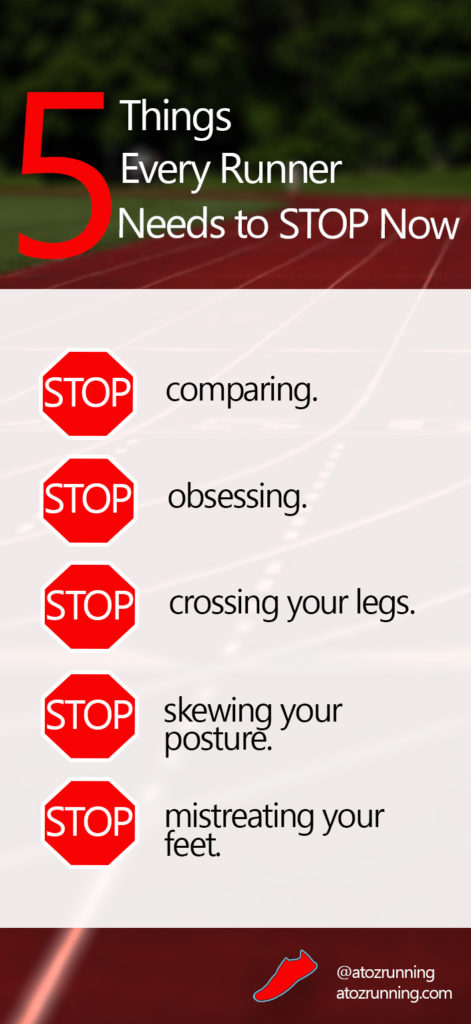5 Things Every Runner Needs to Stop Now
Forward motion is strategic. In the most recent episode of our podcast, we discussed cutting the fat. We’ve made progress by clearing obstacles over the years. The important lesson, for us, has been learning to stop doing the things that jeopardize our health or sanity. Between Zach and me, the list is long. These five are some of the most significant for every runner. (This week we have 5 things every runner needs to stop and next week we will have 5 things every runner needs to start.)

1. Stop comparing.
Theodore Roosevelt famously stated that “Comparison is the thief of joy.” It’s true.
Physical comparison

Stop comparing your transformation to that of others. With the trending #transformationtuesday we see many displays of improvement. Read their intention; it’s to inspire. Congratulations, definitely, to those who have worked hard to make improvements! However, the temptation for the rest of us is to compare. Our success and our growth are our own. Let’s see and celebrate others without making them the standard.
Performance comparison

I am guilty–oh so guilty!–of this. Ever look on Strava or other social apps and immediately feel badly about the training run you just accomplished? I’ve tried to measure my future success based on isolated data of those whom I have arbitrarily decided are of a similar ability to me. The ramifications have been pushing myself in easy runs to try to match them. All it does is hurt training and distract from the purposes of your run. If you need help, you can do what I did and find a more objective measure, like heart rate or running power.
Self comparison
If you’ve ever come back from an injury, you’ve likely struggled with this one. Comparing ourselves to our previous fitness is discouraging. You probably noticed Zach’s comments about this if you read our Chicago Marathon report. Naturally, we want to improve, strive to hit higher goals, but setbacks often require a reset of those goals, allowing for us to find more joy and success by reaching incremental achievements.

2. Stop obsessing.
Easier said than done. The stereotypical runner personality has drive and discipline. According to Brad Stulberg and Steve Magness, it’s also commonly associated with obsessive tendencies or worse.

Zach and I often obsess over the watch. What’s my average pace? Am I hitting decent splits? How far have I gone? What’s my heart rate right now? And right now? And right now? Although data is informative and helpful for workouts, I would argue we do not need to constantly check this feedback on our daily runs (more on that in the Training by Effort section from our Training Guide).

Some of us obsess over food. Food is fuel. It’s important, but our relationship with food is individual and often intimate. I can only speak from experience that an obsession with food, even in simple and small ways, can cause disorder and dysfunction. Strict dieting and distance running rarely work well together. Focusing on nutritional needs, rather than a deficit diet, will help make food a friend, not an enemy.
As a goal-oriented individual I obsesses over future results. I have to remind myself to redirect my focus on today rather than worry about the unknown results of tomorrow. I can’t control tomorrow. This obsession is futile and exhausting. I find it so important to make running about more than performance goals. Here is a brief article on transcendent goals.

3. Stop crossing your legs.
This tip is less philosophical and just plain practical. Because of my injury, I’ve learned these little tips of self-preservation. Uneven motions and positions of all kinds can be dangers to a distance runner, especially when sitting for long periods of time like working in an office or driving a car. Adam’s advice is that unless you’re mindful and can cross your leg on each side for equal amounts of time, it’s better to avoid it altogether.

4. Stop skewing your posture.
While similar to the one above, I learned this lesson in a different way and want to emphasize that difference. I am convinced that for a time, the only way I stood was with one hip or the other “popped” to the side. Having a baby or toddler almost constantly on my hip for the last three and a half years hasn’t helped. Adam brought this bad habit to my attention, and now I find myself noticing others doing the same thing. It’s common. And it’s only one example of the many uneven and unhealthy ways we stand or lean or slouch. Pay attention to your posture.

5. Stop mistreating your feet.

Flip flops? High heels? Crocs (I’m directing this one at ZACH)? Fun and fancy footwear has a place (and may even be necessary for you sometimes, like heels are for me in my job), but it’s also potentially risky. That should at least make us pause when selecting our footwear and weigh the costs. Everyone loves cute shoes. Everyone hates plantar fasciitis.
By the way, the right answer is not necessarily a type of shoe. The key is whether the shoe supports symmetry and balance well.

The Message
You probably already guessed the theme in this post. Be mindful of what you are thinking and doing! We want running to be a joy and a blessing in our lives, not a nag or a frustration. To ensure that it is more joy than frustration, certain things, like those above and certainly others, need to be avoided. Forward motion is easier when we work on these 5 things every runner needs to stop.

Our list might not be the same as yours, so leave a comment below with some of YOUR must-stop items! Then stick around for our next post when we will share 5 Things Every Runner Needs to START Now (or continue).












That’s good to know that your shoes could damage your feet. I don’t want to develop plantar fasciitis. I’ll have to consider getting a podiatrist to help me find some good shoes to help me with that.
Re asymmetry: Dave Ramsey would scold me (or use me as an object lesson), but I’ve often wondered if the reason I have trouble with my left IT band is because that’s the side where I’ve kept my wallet for many years. I’m suspicious if it has gradually pushed my greater trochanter anterior.
Oh man… I can think of a few others who might second that consideration, Kevin!
The PTs I’ve worked with in the last decade have all puzzled over my right hip (my entire right leg from hip down has a slight external rotation compared to the left).
Adam (our present PT) is the first one to walk through all of the common routines of my life until we discovered that when I drive, my right foot always rests slightly to the left of the gas pedal so that when needing to press the gas pedal (the majority of drive time), my leg rotates externally.
Be it Dave Ramsay or Adam Homolka, there’s probably support for your wallet-to-ITB consideration.
Whenever I’ve had sciatica pain, it’s always with long periods of driving because my right hip tends to dip lower than the left. I can also relate to Andi’s baby carrying asymmetry. My bike fitter noticed this on me; he was perplexed until he saw my two kids ?